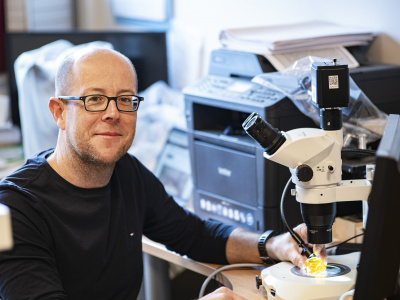Over 100 million years, ants have hardly changed, and prehistoric wasps once fed mainly on plants. What else we can learn from inclusions in amber is told by prof. Vincent Perrichot from the University of Rennes (France). The biologist came to the Department of Invertebrate Zoology and Parasitology as part of the UG Visiting Professors programme.

Marcel Jakubowski: To find out about ancient insects, you’ve studied both amber and rock imprints. Are there any other ways to get information about ants or wasps that lived millions of years ago?
Prof. Vincent Perrichot: When you study the evolution and the history of insects, you have to base your knowledge on those two sources, which are the unique witnesses of extinct lineages. They are both very different preservation methods. Imprints are flattened, which makes it tricky to find out about some morphological structures. Amber saves everything in three dimensions. Personally, I work mostly on amber. Even if a rock imprint is very nicely preserved, you still get less information from it than from amber.
One of your main research focus is ants. How did those insects or their ancestors change over the last millions of years?
The earliest ants that we can find are from about 100 million years old. Over this time, there were rather minor changes to the general morphology of ants. The first known species exhibit two main morphologies: one that at a quick glance looks very much like the modern ant, but with few differences at a closer inspection; and one with strikingly different heads, particularly regarding the mandibles. This still doesn’t change the fact that anyone, even someone not familiar with entomology, could probably recognise it’s an ant.
Would you call ants an evolutionary success?
It is certainly a big success. The first ants appeared in the Cretaceous period, so right with the dinosaurs. Insects in general are much older, at least 400 million years old, so ants are quite a recent insect lineage. But while they stayed moderately diversified during the Cretaceous, they diversified and adapted rapidly to many environments after the end-Cretaceous mass extinction. Now, they are ubiquist, adapted to almost every ecosystem, so that’s quite a success in evolution.

From left: prof. Vincent Perrichot and dr hab. Jacek Szwedo, prof. UG (host of the visit)
You’ve written a few research papers with prof. Jacek Szwedo about Ethiopian ants trapped in amber. What did you find out from those discoveries?
Ants from Ethiopian amber are about 15 million years old. Until this discovery, there were virtually no ant fossil deposits in the whole of Africa, so it is highly interesting to fill this evolutionary gap. We found there some ant lineages that are now present in southeast Asia but have vanished from Africa. At the same time, it’s hard to collect Ethiopian amber because it’s a business for locals. You cannot go by yourself and excavate it; you have to travel to the deposit site, study its geology and buy the amber.
What’s the largest thing to ever be preserved in amber?
Usually, in amber, you can find only small creatures - because a larger organism can escape from the fresh resin. In some exceptional cases, resin traps dragonflies, that are 5 or 6 cm long. Rarely it’s some other organism, such as vertebrates or their remains. In the Baltic or Burmese amber, there are some cases of small lizards and hatchling birds inclusions.
During your research of Burmese amber, you found extinct wasp subfamilies. Why didn’t they survive?
Most probably, all these ancient lineages died out because of the changing environment. At the time of Burmese amber, which is about 100 million years old, the Earth was the warmest it has ever been. The forests were made of conifers, but as our planet began to cool down, this changed. The flowering plants started to emerge and dominate, so insects had to adapt to a new food source. Some subfamilies couldn’t do that.
How did wasps change throughout history?
They were still wasps, so in some way, they didn’t change much. Some extinct subfamilies show structures that don’t exist anymore in modern species. Ancient wasps fed mostly on plants, but with time, they became parasitoids. It’s not something you can observe from the outside. You need to study the specimens closely.
In 2022, you finished a project about Chinese and other Asian ambers. How is this amber different from European and African Amber?
Amber remains amber; it doesn’t matter if it comes from Europe, Asia or Africa, but the plants that produce it differ from each other. Ethiopian amber from 15 million years ago was produced by a flowering plant, Burmese Amber was produced by a conifer, so they provide snapshots of different ancient forest ecosystems.
What will you talk about during your lectures here at the University of Gdańsk?
The first lecture will be about the origin and rise of the ants from the very beginning to now. The second one will be about the production and preservation of plant resins through time. And the last lecture will be about the insect fossil deposits from France. We are lucky to have numerous deposits with various insects from different periods of time.

- W 2022 zakończył Pan projekt dotyczący chińskich - i ogólnie azjatyckich - bursztynów. Czym różnią się one od tych europejskich lub afrykańskich?
- Bursztyn pozostaje bursztynem, niezależnie skąd pochodzi, jednak rośliny, które go wyprodukowały, różnią się między sobą. Etiopski bursztyn sprzed 15 milionów lat został wyprodukowany przez rośliny kwitnące, natomiast birmeński przez rośliny iglaste - oferują one zatem wgląd w inne prehistoryczne ekosystemy leśne.
- O czym będzie Pan mówił podczas swoich wykładów w Uniwersytecie Gdańskim?
- Pierwszy wykład będzie poświęcony pochodzeniu i rozwojowi mrówek od ich początków aż po czasy obecne. Drugi będzie dotyczył i produkcji i zachowywania żywicy roślinnej na przestrzeni dziejów. Ostatni natomiast skupi się na skamieniałościach z terenów Francji. Mamy szczęście, gdyż dysponujemy licznymi złożami z rozmaitymi skamieniałymi owadami, z różnych okresów czasu.
